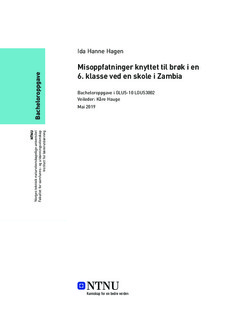| dc.contributor.advisor | Hauge, Kåre | |
| dc.contributor.author | Hagen, Ida Hanne | |
| dc.date.accessioned | 2019-08-23T14:06:25Z | |
| dc.date.available | 2019-08-23T14:06:25Z | |
| dc.date.issued | 2019 | |
| dc.identifier.uri | http://hdl.handle.net/11250/2610184 | |
| dc.description.abstract | Temaet for denne oppgaven er misoppfatninger knyttet til brøk i en 6. klasse ved en skole i Zambia, og problemstillingen jeg har valgt er: Hvilke misoppfatninger innenfor brøk kan man finne i en 6. klasse ved en skole i Zambia, og på hvilke måte kan misoppfatningene oppdages?
For å kunne besvare denne problemstillingen har jeg i hovedsak valgt å gjøre en kvalitativ analyse av elevers svar og fremgangsmåte på ulike oppgaver. På denne måten skal jeg se på hvilke misoppfatninger knyttet til brøk man kan fange opp i en 6. klasse ved en skole i Zambia, og samtidig ha fokus på hvordan disse misoppfatningene kan oppdages. Oppgavene som ble gitt til elevene var diagnostiske og hadde til hensikt å oppdage misoppfatningene.
Analysen jeg har utført har ført til ulike funn. I hovedsak går funnene ut på at mange elever sliter med de samme misoppfatninger innenfor brøk, noe som gjaldt både sterke og svake elever. Noen elever har misoppfatninger knyttet til hva brøk egentlig er, andre elever tror at teller og nevner er to separate verdier, mens noen elever har misoppfatninger knyttet til at størrelsen på de ulike delene som brøken representerer må være like store. Disse funnen skal jeg se i lys av tidligere forskning på misoppfatninger i brøk, konstruktivistisk teori og instrumentell og relasjonell forståelse i matematikk. | |
| dc.description.abstract | The topic of this assignment is misconceptions related to fractions in a 6th grade at a school in Zambia, and the thesis I have chosen is: Which misconceptions within fraction can be found in a 6th grade at a school in Zambia, and in what way can the misconceptions be discovered?
In order to answer the thesis, I have mainly chosen to make a qualitative analysis of the students' answers and approaches to different tasks. In this way, I will look at what misconceptions related to fractions one can identify in a 6th grade at a school in Zambia, while also focusing on how these misconceptions can be discovered. The tasks given to the students were diagnostic and intended to detect the misconceptions.
The analysis I have conducted has led to various findings. The main findings are that many students struggle with the same misconceptions within fractions, which apply to both strong and weak students. Some students have misconceptions related to what fraction really is, other students believe that the numerator and denominator are two separate values, while some pupils have misconceptions linked to that the size of the different part that the fraction represents must be equal. These findings will be discussed in relation to previous research on misconceptions in fractions, constructivism and instrumental and relational understanding in mathematics. | |
| dc.language | nob | |
| dc.publisher | NTNU | |
| dc.title | Misoppfatninger knyttet til brøk i en 6. klasse ved en skole i Zambia | |
| dc.type | Bachelor thesis | |
